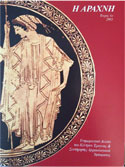February's word: Cannabis
Cannabis seems to have existed since the Neolithic period, however, the oldest mention of the term is found in Herodotus (ca. 440 BC) when he speaks about the Scythians and Thracians and informs us of the production of cloths from this plant and of its advantages against flax:
Ἔστι δέ σφι κάνναβις φυομένη ἐν τῇ χώρῃ πλὴν παχύτητος καὶ μεγάθεος τῷ λίνῳ ἐμφερεστάτη· ταύτῃ δὲ πολλῷ ὑπερφέρει ἡ κάνναβις… (IV.74),
He also informs us of its use as a psychotropic/psychoactive substance:
τὸ δὲ [τῆς καννάβιος τὸ σπέρμα] θυμιᾶται ἐπιβαλλόμενον καὶἀτμίδα παρέχεται … οἱ δὲ Σκύθαι ἀγάμενοι τῇ πυρίῃ ὠρύονται…
In the beginning, cannabis was probably local in Central Asia. However, as it spread during thousands of years through human intervention, it is no longer possible to locate the routes of its natural distribution.
And neither the history of the term, let alone its etymology, is known to us with certainty. Some regard it as Indo-European, some as Semitic. The Greeks, and later the Romans have known it from the Scythians, *kanba, and gave it to the Germanic populations: *hanapiz > hanaf > modern Hanf; to the Anglosaxons > hœnep > hemp (and canvas), to the Latin languages (chanvre, canapa, cáñamo etc.).
In high probability, it was the Scythians who gave the term and meaning to their cousins the Medes, the Persians (kanab) and the Sakes who travelled as far as China (kaṃhā). In finno-hungarian, we find the term kenē, in Sanskritic šaṇás (k > s) and bhanga (from which the Persian bang?), in Semitic Hebrew p(b)annag and qannabbôs (> kanbos), Syrian qunnappa, Arab kunnab. The Soumerian term is kunibu.
The term must, therefore, be regarded as Wanderwort, as is is called in linguistics, namely a wandering term, as well as the object it identifies, which travelled from Central Europe to the Mediterranean, Mesopotamia, Middle and Far East – and today around the globe.



